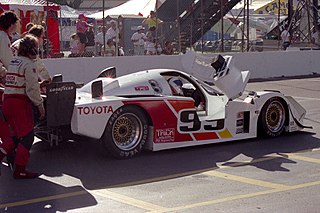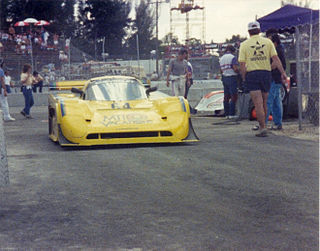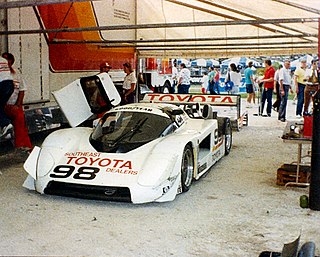
The 12 Hours of Sebring is an annual motorsport endurance race for sports cars held at Sebring International Raceway, on the site of the former Hendricks Army Airfield World War II air base in Sebring, Florida, US. In the past, this race has been a round of the now defunct World Sportscar Championship, IMSA GT Championship and American Le Mans Series. In 2012, the race was the opening event of the FIA World Endurance Championship in a one off race before being returned back to the American Le Mans Series for 2013. Starting in 2014, the event became the second round of the WeatherTech SportsCar Championship.

All American Racers is an American-licensed auto racing team and constructor based in Santa Ana, California. Founded by Dan Gurney and Carroll Shelby in 1964, All American Racers initially participated in American sports car and Champ Car races as well as international Formula One events with cars named Eagle. The Formula One team, based in the United Kingdom and using British-built Weslake engines was named Anglo American Racers. Under team manager Bill Dunne they set up shop in Rye, East Sussex. The team were adjacent to Harry Weslake's engine development plant and half a mile from Elva cars. They participated in 25 Grands Prix, entering a total of 34 cars.

Parnell Velko "P. J." Jones is an American professional racing driver. He has contested in multiple disciplines, including NASCAR, IndyCar, IMSA GT Championship, the American Le Mans Series, USAC, the Chili Bowl, and the Stadium Super Trucks.

Juan Manuel Fangio II is an Argentine former auto racing driver. He is the nephew of five-time Formula One champion Juan Manuel Fangio.
The 1981 World Sportscar Championship season was the 29th season of FIA World Sportscar Championship motor racing. It featured the 1981 FIA World Endurance Championship which was contested over a fifteen race series which ran from 31 January to 27 September. The former World Challenge for Endurance Drivers was renamed to the World Endurance Championship of Drivers for 1981 and the World Championship of Makes was renamed to the World Endurance Championship of Makes. Bob Garretson won the World Endurance Championship of Drivers and Lancia was awarded the World Endurance Championship of Makes.

The Eagle Mk1, commonly referred to as the Eagle T1G, was a Formula One racing car, designed by Len Terry for Dan Gurney's Anglo American Racers team. The Eagle, introduced for the start of the 1966 Formula One season, is often regarded as being one of the most beautiful Grand Prix cars ever raced at the top levels of international motorsport. Initially appearing with a 2.7L Coventry Climax inline 4-cylinder engine, the car was designed around a 3.0L Gurney-Weslake V12 which was introduced after its first four races. In the hands of team boss Gurney, the Eagle-Weslake won the 1967 Belgian Grand Prix, making Dan Gurney only the second driver at the time, and one of only three to date, to win a Formula One Grand Prix in a car of their own construction. Excluding the Indianapolis 500, that win in Belgium still stands as the only win for a USA-built car as well as one of only two wins of an American-licensed constructor in Formula One. It was also the first win for an American constructor in a Grand Prix race since the Jimmy Murphy's triumph with Duesenberg at the 1921 French Grand Prix.

Spice Engineering was a British racing team founded by driver Gordon Spice with Raymond Bellm in the early 1980s, later becoming a successful sports car constructor in 1986. They competed in the World Sportscar Championship in Europe as well as the IMSA GT Championship in North America, at times partnering with major manufacturers such as General Motors and Honda as well as race engine manufacturer Comptech.

IMSA GT was a sports car racing series organized by International Motor Sports Association. Races took place primarily in the United States and occasionally in Canada.

Grand Touring Prototype (GTP) is the name of a former classification designated to sports prototypes in sports car racing competing in the IMSA GT Championship, maintained by IMSA between 1981 and 1993. The early cars were based on the almost same identical ruleset as the FIA's Group C category, but eventually evolved into a separate category. It was the successor to the Grand Touring Experimental (GTX) class, which were based on FIA Group 5 and Group 6 cars.

Bob Earl is an American former racing driver from Claremont, California. He began racing in Formula Ford in 1972 and was the 1973 national champion. In 1979 he made his professional debut in Formula Atlantic. In 1981 he became the only American to win the Macau Grand Prix, driving a modified Hayashi 320. At the time, the race was contested with Formula Atlantic cars.

The Nissan NPT-90 was a racing car developed in 1990 for Nissan Motors by Nissan Performance Technology Incorporated (NPTI), formerly known as Electramotive Engineering. It was a replacement for the highly successful GTP ZX-Turbo that had won the IMSA GT Championship in 1989. The NPT-90 would go on to win the championship in 1990 and 1991 before being retired by Nissan at the end of the 1992 season.

The Mazda RX-792P is a sports prototype racing car built for the IMSA GT Championship's GTP category for Mazda. Its career was short lived, with only two cars running in 1992 before the project was abandoned.
The 1992 Camel GT Championship and Exxon Supreme GT Series seasons were the 22nd season of the IMSA GT Championship auto racing series. It was for GTP and Lights classes of prototypes, as well as Grand Tourer-style racing cars which ran in the GTS, GTO, and GTU classes. It began February 1, 1992, and ended October 11, 1992, after fifteen rounds.
The 1990 Camel GT Championship season was the 20th season of the IMSA GT Championship auto racing series. It consisted of GTP and Lights classes of prototypes, as well as Grand Tourer-style racing cars which ran in the GTO and GTU classes, as well as a tube-frame All-American Challenge (AAC) class during select GT-only rounds. It began on February 3, 1990, and ended November 11, 1990, after twenty rounds.
The 1988 Camel GT Championship season was the 18th season of the IMSA GT Championship auto racing series. It was for GTP and Lights classes of prototypes, as well as Grand Tourer-style racing cars which ran in the GTO and GTU classes. It began January 30, 1988, and ended October 23, 1988, after seventeen rounds.
The 1982 Camel GT Championship season was the 12th season of the IMSA GT Championship auto racing series. It was the first year of the GTP class, which combined the previous GTX class of Group 5 cars and prototypes. Other competitors ran in the GTO and GTU classes of Grand Tourer-style racing cars. It began January 30, 1982, and ended November 28, 1982, after nineteen rounds.
Jeremy Dale is a Canadian racing driver. His career in motorsports has spanned more than 30 years as a racer, television commentator, race series director, race team president, and race team owner.

The Toyota 88C was a racing car entered by Toyota from 1988 to 1989. It is the successor to the Toyota 87C and the predecessor to the Toyota 88C-V. Like other Toyota-powered sports prototypes of the era, it was designed and built by Dome. The 88C is an evolution of the 87C, both models sharing the same chassis number designation. The 88Cs competed in the All Japan Sports Prototype Championship, the World Sports-Prototype Championship, and the North American Camel GT Championship.

The Eagle MkIII is a sports prototype racing car built by All American Racers in 1991 to IMSA GTP specifications. Powered by a turbocharged Toyota inline-4 engine, the car was campaigned in the IMSA Camel GT series by Dan Gurney's Toyota-sponsored AAR team from 1991 through to the end of 1993. The Eagle MkIII won 21 out of the 27 races in which it was entered and is considered one of the most successful and technologically advanced designs of the IMSA GTP era — "a car that proved so overwhelmingly dominant that the class for which it was created has now been assigned to history", according to Racer magazine.

The Intrepid RM-1 is a sports prototype racing car designed in 1991 by Bob and Bill Riley and built by Pratt & Miller to IMSA GTP specifications. Powered by a Chevrolet V8 engine, it was campaigned variously by Jim Miller, Prototype Technology Group and Wayne Taylor in the IMSA Camel GT from 1991 through 1993. Though it won only one race in its three seasons of competition, the shovel-nosed Intrepid was notable for the extreme—and at one point, disastrous—levels of downforce it generated, giving it the highest cornering speeds of any prototype of its era. The car's development was set back by a devastating 1991 crash at Watkins Glen that critically injured driver Tommy Kendall, and the program never fully recovered.














